« May 2005 | Main | July 2005 »
June 17, 2005
Char Dham Yatra - 2
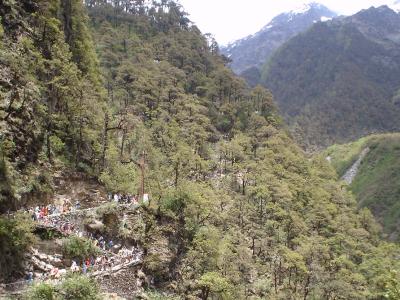
The climb to Yamunotri begins
We left Barkot early the next morning and followed the gorge hacked out by the Jamuna River to the hot springs of Janak Chatti, where the arduous trek to the river's source begins. In the company of hundreds of other pilgrims, some on horse back, some carried in 4-man pankies or palanquins, I walked the steep and twisting paths up the hills to the temples at Yamunotri.
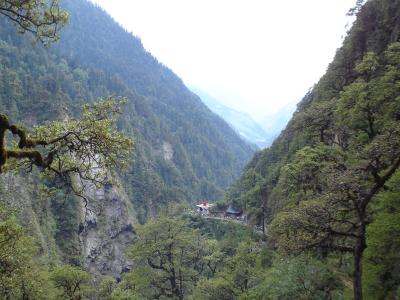
Into the mountains
The six kilometre track zig-zags through beautiful mountain scenery, though it is often difficult to watch when concentrating on the climb itself. Luckily for the weary trecker, frequent teastalls have been set up along the way, in caves or under canvas awnings. What a relief it is to take a break for the cup that cheers.
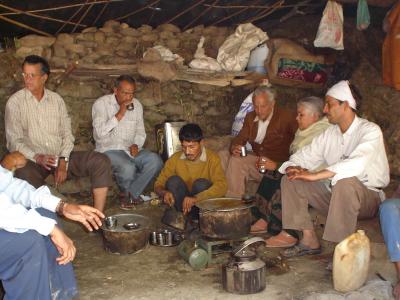
A welcome stop for tea
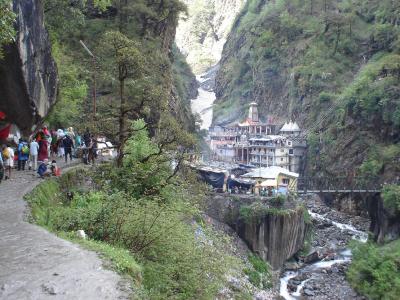
First view of the Yamunotri temples
At last, at 3185 metres, the final bend is reached, and the welcome view appears before us: the group of temples nestling in the gorge below the glacier that forms the start of the holy river Jamuna, that will snake its way down the hills and across Uttar Pradesh, passing the capital city Delhi, the Taj Mahal in Agra, and beyond into the plains of Northern India.
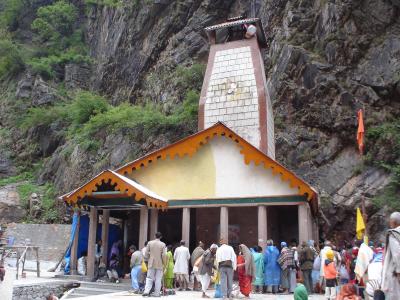
The main Yamunotri temple
The pilgrims perform puja in the temples, then take their sacred bath in the icy river waters, and in the hot sulphurous springs that occur naturally here. At their source, some rice or potatoes wrapped in a cloth can be quickly cooked, and are often offered as prasad in the temple before being eaten.
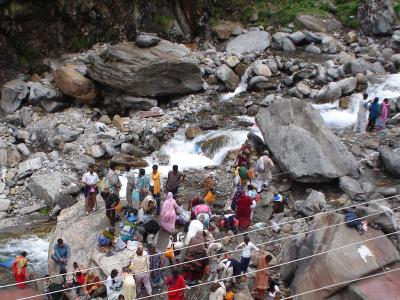
A bathe in the icy Jamuna river
After some time appreciating the holy aura and natural beauty of the surroundings, we made our way down the mountain, and after a night's rest, continued on the road along the valley of the Khurnala Gad to the second of the holy rivers, the Bhagirathi, that will eventually become the holiest river of all, Mother Ganges.
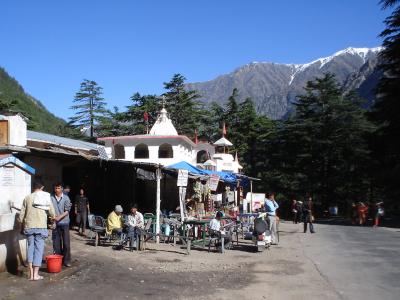
Teastalls at Bhairon Ghati
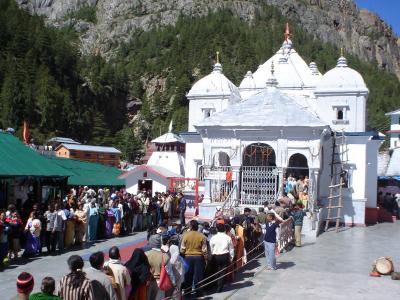
The Gangotri Temple
We drove along the Bhagirathi river valley, higher and higher into the mountains, passing through the market town of Uttarkashi, and the military base at Harsil, an important key to the Lamkhaga Pass into China. Gangotri, at 3140 metres, is surrounded by pine and deodar-clad mountains, with plenty of snow in evidence. Numerous holy men and sanyasins line the temple approaches, and a big queue soon forms for entry to the temple itself. On the nearby river banks, bathing ghats allow the faithful to take their ritual dip, an act that will wash away all their sins. Nearby, at the point of a great waterfall, is the place where it is believed that the Ganges River literally came down to earth, cushioned in Lord Shiva's hair.
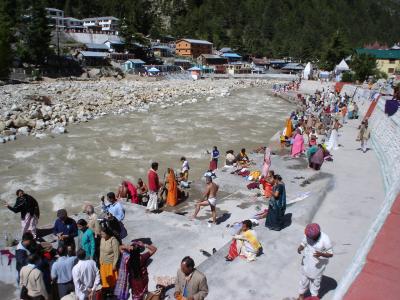
Bathing ghats at Gangotri
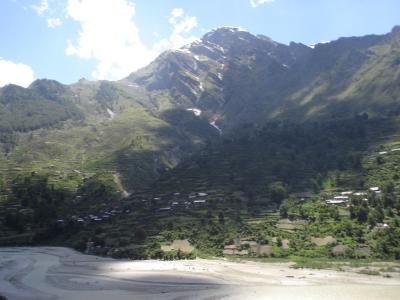
Mountains around Gangotri

Bhagirathi river valley
Our next destination was the temple at Kedarnath. A direct route would go over the Khatling Glacier, and cross numerous mountain peaks of 6500 metres and more, so like most pilgrims, we retrace out path back down the Bhagirathi river valley to the busy town of Tehri, where the road heads east as far as Rudraprayag, the confluence of the Alaknanda and Mandakini rivers. Here we headed north, up the Mandakini river valley, along treacherous tracks that hug the sheer mountain sides, eventually to reach the little town of Gauri Kund, where the road ends and a steep climb of some 14 kms begins, up to the Kedarnath Temple at some 3584 metres. Like at Yamunotri, horses and palanquins are available to hire for the elderly and infirm, but I opted once again for the arduous and tiring climb to the top, and enjoyed it very much, as long, that is, as I remembered not to look too far ahead at one time !
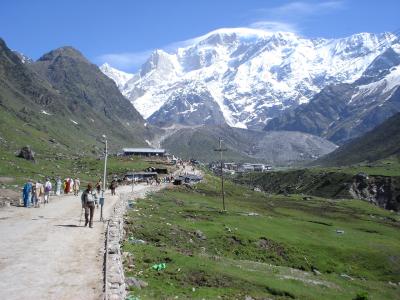
Nearing Kedarnath
Kedarnath, and its temple, are set in stunning mountain surroundings, with the rushing Mandakini river nearby, and numerous snow capped mountain peaks as a frame to the temple itself. The temple, believed to be about 800 years old, is built of stone, unpainted but carved on the outside, with a wooden-roofed mandapa. Indside is one of the 12 jyotirlingas of India: believed to be 'swayambhu', or born of itself.
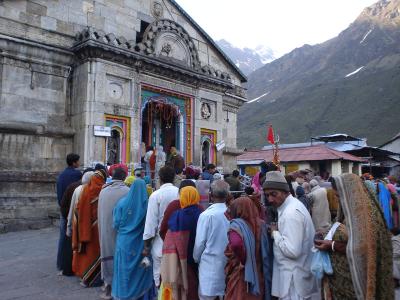
The Kedarnath temple
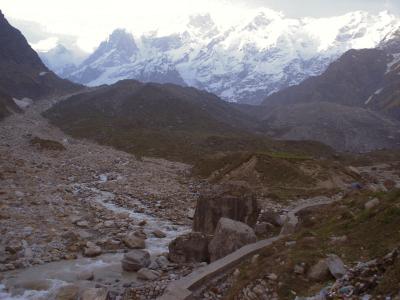
Mandakini River at Kedarnath
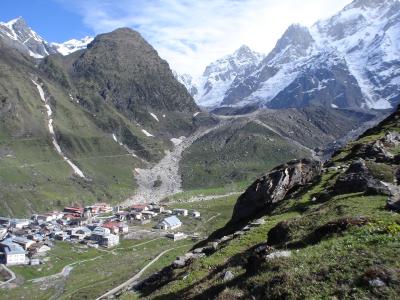
The town of Kedarnath
Though hot and humid on the plains, the temperature at Kedarnath was very chilly, and I was grateful for the two thick quilts on the bed at the spartan but adequate GMVN lodge there. The staff were most helpful, and soon served me with a piping hot bowl of tomato soup, rotis, and a tasty vegetable curry. After all that day's climbing, sleep did not take long to arrive!
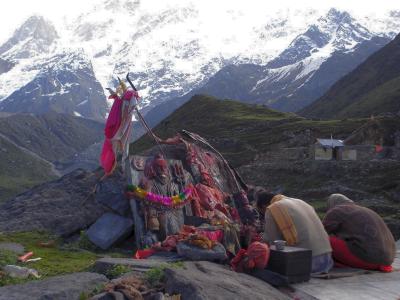
A mountain-top shrine to Shiva - 1
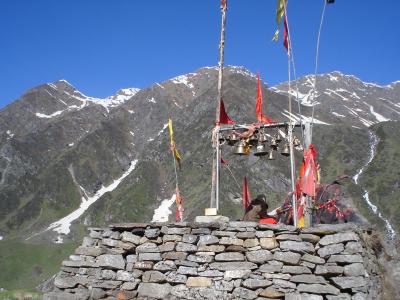
A mountain-top shrine to Shiva - 2
The next morning, I climbed a bit further into the mountains to visit a shrine dedicated to the god Shiva. Though early, two priests were already there, performing the ritual devotions, and well wrapped up against the chilly mountain air. I stayed a while, admiring the stunning views, then all too soon started the long trek back down the mountain to Gauri Kund, where our coach waited to take us on the final leg, a further two-day journey along terrifying roads, through the towns of Karna Prayag, Chamoli, and Joshimath, to the river valley of the Alaknanda, and its startling hair-pin bends that pulled the road up to the holiest of all temples, Badrinath.
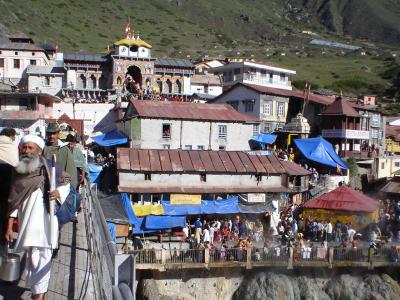
Badrinath Temple
Located at a height of 3122 metres, Badrinath, a Vishnu temple, is one of the 4 holy abodes of Hinduism, an honour it shares with Dwarka in the east, Ramesvaram in the south, and Puri in the east: no pilrimage can be complete without a visit here. From 04:00 each morning, the lines of pilgrims waiting to enter the temple snake long along the banks of the Alaknanda, past the bathing ghats where the pious (and hardy) commence their worship with an icy ritual bathe. As at Yamunotri, natural sulphur springs also rise to the surface here, a welcome alternative for the bather.
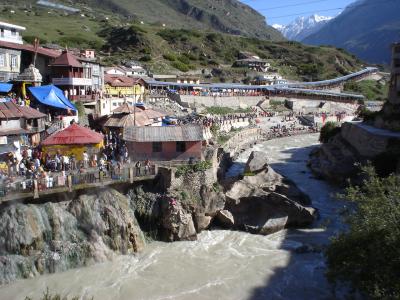
Bathing ghats at Badrinath
Leaving Badrinath the next morning, there only remained a final two-day journey to complete the circle, and return us to our starting point of Rishikesh. I feel very honoured to have been allowed to experience the Char Dham Yatra with such a lovely group of Indian pilgrims, and thank them all for their patience when explaining some of the many finer points of their religion.
23-06-05 Unfortunately, my laptop hasd developed a fault, and it is unlikely that I can get it working again before I return to Ireland. It is therefore unlikely that there will be any more diary pages after this one. I hope you have all enjoyed viewing my photos and reading the text. Please email me to say hello - the address is on the Contact page.
Posted by travellingtim at 11:51 AM | Comments (0)
June 08, 2005
The Char Dham Yatra
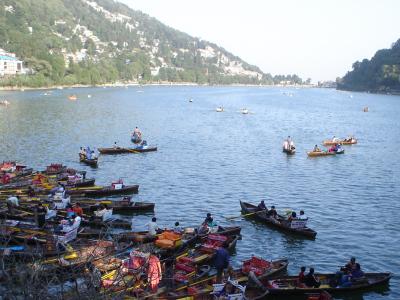
The Naini Tal, at Nainital
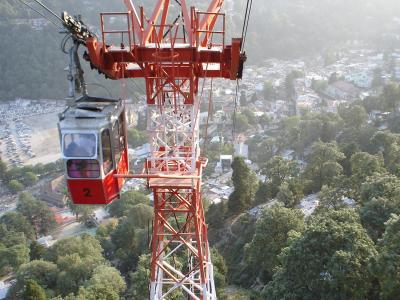
Nainital Ropeway
Despite six previous trips to India, and a marked preference for hill stations, a visit to Nainital, in lower Uttaranchal, had always alluded me, despite having heard so much about it from other travellers. This trip, therefore, I made a special point of catching the bus from Haldwani for the long climb into the hills, and a chance to see for myself.
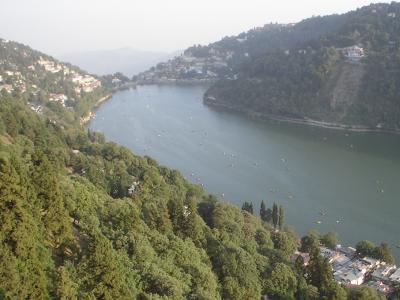
Looking down on Nainital
I was sorely disappointed. Thronged with hundreds and thousands of eager holiday-makers, this once quiet resort had turned into the Blackpool of the Hills, with little more enchantment that the afore-mentioned English seaside town. Gaming machines, rowing boats and pedaloes in the shape of giant ducks, restaurants with barkers outside, and a myriad of gift shops selling tacky Chinese souvenirs; it took very little time to convince that for me at least, Nainital was not the place to pay homage to India or the mountains. After a brief one-night stay, I left for the much more interesting and very ancient city of Haridwar, on the holy Ganges River.
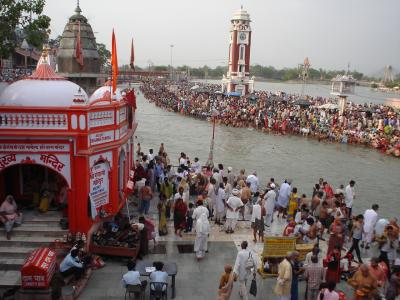
Haridwar
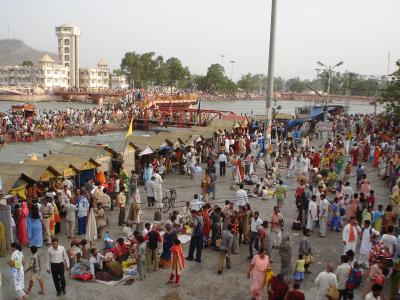
The banks of the River Ganges
Busy enough throughout the year, Haridwar, said to be one of the oldest cities in the world, was likewise packed with a teeming throng of Indians. But unlike Nainital, these Indians had come not for pleasure but for the serious business of Pilgrimage. Legend has sanctified the city by placing the god Vishnu's footprint on the river bank, making Haridwar one of the seven holy cities of Hinduism. From sunrise to sunset, pilgrims come to bathe from the ghats to cleanse themselves of their sins. Priests perform puja, and holy men and sadhus wander the banks, begging for alms.
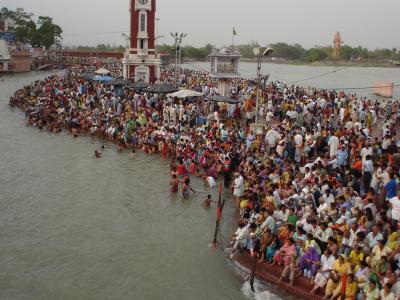
The crowded bathing ghats

Haridwar street-scenes
Haridwar is also famous as being the starting point for the mighty Hindu pilgrimage known as the 'Char Dham Yatra', that visits four of the holiest temples in the Uttaranchal Himalayas: Yamunotri, Gangotri, Kedarnath, and the holiest of all: Badrinath. This religious journey, or Yatra, had for many years been something that I wanted to experience, and was the main reason that I had made this visit to India during the summertime, the only period when the high hills and mountain passes were clear enough of snow and ice to let the Yatra take place. Unlike Nainital, I was not to be disappointed, and enjoyed my journey with Indian pilgrims very much indeed.
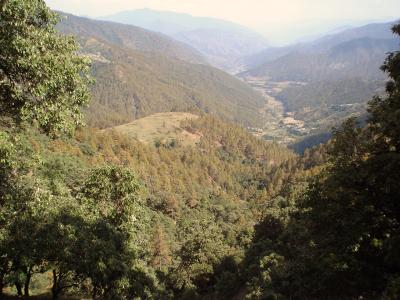
Into the mountains
To experience the Yatra to the full, and to learn some of the importance and religious significance that calls many hundreds of thousands of pilgrims from all over India to make the arduous journey each year, I decided it would be more appropriate to travel with a group of Indians, rather than by myself, so joined a 10 day tour organised by specialists GMVN.
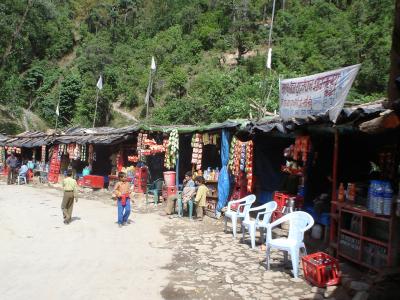
Roadside tea-stalls
Our bus set off into the hills, soon leaving Rishikesh and the Ganges plains behind, and heading over the Nag Tisha range of mountains for the first night's stop in the pine-clad village of Barkot. Our adventures had begun!
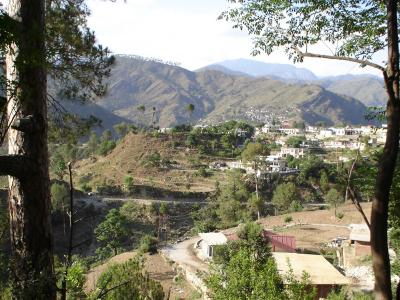
Barkot
Posted by travellingtim at 09:33 PM | Comments (0)
June 03, 2005
Darjeeling, Queen of Hill Stations
Back into India, and the cloying summer heat and humidity of Kolkata made me run for the hills: in this case, Darjeeling, a popular retreat for the inhabitants of West Bengal. Situated in the lower Himalayas, between the mountain kingdoms of Nepal and Bhutan, its 6000 foot elevation makes the weather very pleasant: the hotel bedrooms don't need ceiling fans, and the beds even have blankets on them!

View from my bedroom
The town was very full, and it took me a while to find somewhere to stay: most unusual for the traveller in India. I eventually got a nice room at the Fairmont Hotel situated at the quiet end of the Mall, and with a lovely view from my bedroom window.

Breakfast at Glenarys
Although I am normally a very frugal traveller, managing on a budget that would be unthinkable in Europe or the US, there comes a time, every now and then, to splash out a little. My weakness is a nice breakfast, and at Glenarys in Darjeeling, you can get one of the best in India. Here I am, about to enjoy a perfectly cooked tomato and onion omelette, with thick brown toast, fresh butter, local honey, and a freshly brewed pot of coffee. The price for all this ? - about 1.20 GBP, or 2.00 USD.

Darjeeling town
Darjeeling has many pleasant walks, along the levels that have been cut into the hillsides. One of the highest is the walk around Observatory Hill, that leads off the end of the Chowrasta, at the norhtern end of the Mall. In the winter and spring time, there are fine views of distant snow capped mountains; at this time of year, though, the clouds and haze limit just how far you can see.

An old British cemetery
To the west is an old British cemetery, and I went to visit the old man who looks after the graves, and to wander around the different plots, reading the faded inscriptions, and wondering about these people who died so far from home, never to return there. The graves are well looked after, if in a rather individual manner. Many flowers are growing randomly about, and vegetables are dotted between the tombs. This style mat not appeal to the the regimented ex-rulers of the Raj, but to me, it was most appealing, and a pleasant place to sit and think.

Forest on Observatory Hill

Lloyds Botanical Gardens
Just below Observatory Hill are the fine Lloyds Botanical Gardens, built on what must be one of the steepest plots anywhere. You have to be fit to enjoy the flowers here! There are many trees to provide a welcome shade, plus ponds, rock gardens, an orchid house, and an interesting herb garden that features a large variety of the local medicinal plants.
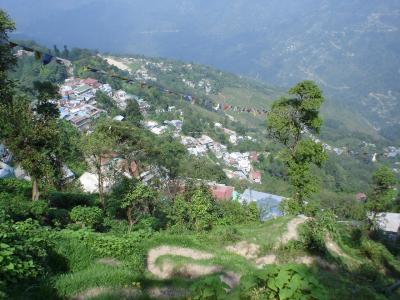
View from Observatory Hill
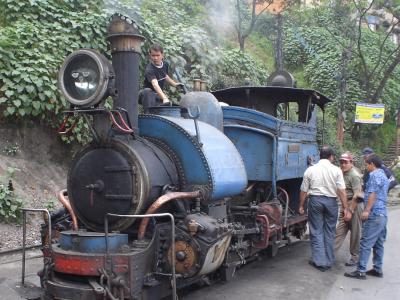
A DHR locomotive
One reason many come to Darjeeling is to see and travel in the world-famous Darjeeling Himalayan Railway, now a World Heritage Site. This amazing railway with its narrow gauge steam locomotives was built near the end of the 19th century, and still provides and important transport service over its 82km length. With gradients of up to 1 in 19, and a maximum height at Ghoom of over 7400 feet, this astonishing railway threads itself in and out of the traffic as it makes the long haul from the plains.
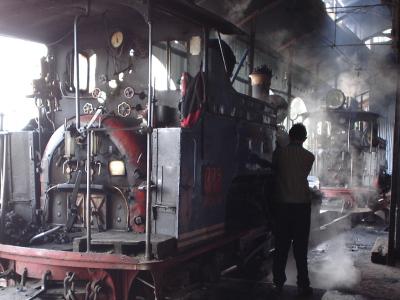
Inside the workshops
Although not counting myself as a 'steam buff' or 'railway specialist', I still like to travel on the trains whenever possible; especially so when steam is involved with its magical smell of hot oil and smoke, and the lovely sounds the engines make when starting or going along the rickety track.
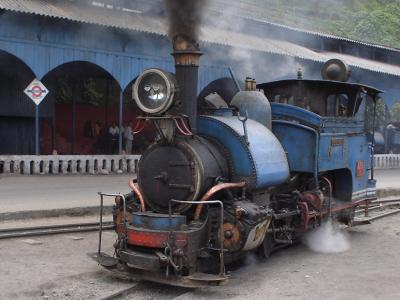
Approaching the carriages
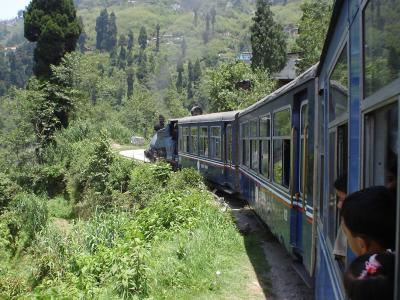
Through the hills
It was, perhaps, not such a pity that the train from New Jalpaiguri to Darjeeling was fully booked when I arrived, as the 8 hour trip can be taxing to even the most hardened enthusiast, but luckily space was available a few days later on the round trip excursion train from Darjeeling to Ghoom and back. This trip is always steam-hauled, and stops for photos at the famous Batasi Loop, where the track makes a complete loop and then crosses itself over a bridge, an ingenious way to gain height that makes use of a natural mountain rock formation, conveniently sited.
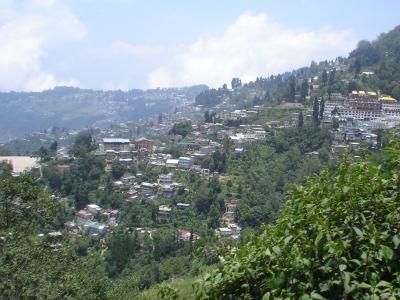
Approaching Darjeeling
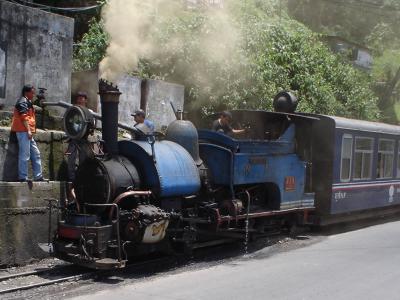
A stop for water
Posted by travellingtim at 09:28 PM | Comments (0)
